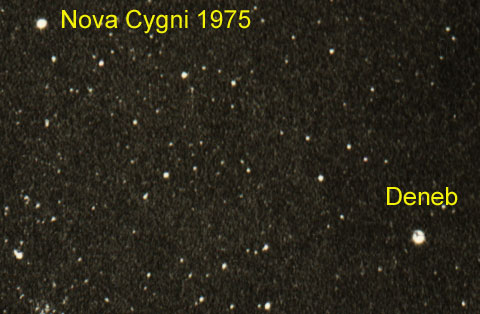| Althought the word nova (plural: novae) is
latin for new a nova is not a new star. It is an existing star that suddenly
brightens by a few hundreds up to a million times by blowing its outer
layers of gas into space. The precise mechanism responsible for the
brightening is not known, but scientists think a novae are part of binary
star systems, consisting of a white dwarf and a red giant. Gas flowing from
the red giant to the white dwarf. Gas reaching the surface of the white
dwarf may trigger nuclear fusion, and the energy released in this process
blows away the outer layer.
The picture on the left shows the most spectacular nova of the past
half century, Nova Cygni 1975 in the constellation of the Swan (Cygnus). Discovered on 29 August 1975, it reached
magnitude 1.8 a few days later, and remained visible during the first
week of September.
The picture is taken on August 30, 1975 at 20:39 GMT, with a Mamiya SLR
and 50 mm lens. Exposure time was 30 seconds on Kodak Tri-X. The picture
shows that the nova was almost as bright as Deneb (α Cyg), a first
magnitude star. |
 |

